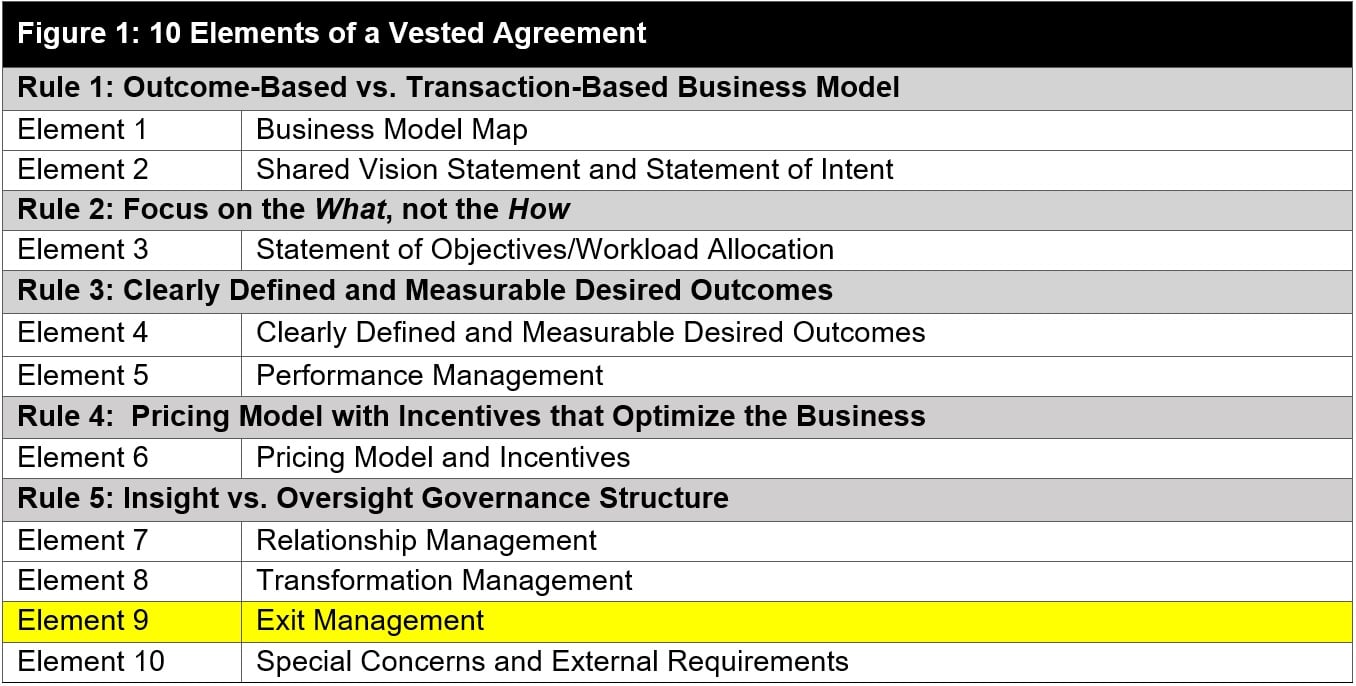Inside Supply Management Magazine
Strategic Contracts: Exit Management
(Editor’s Note: Inside Supply Management® Weekly recently published “Implementing a Successful Supplier Sourcing Contract,” which highlighted why strategic supplier relationships should use all of the tools in the contracting toolkit. This article is the ninth in a series that explores each of the 10 elements that craft successful buyer-supplier contracts, as described in the book The Vested Outsourcing Manual. This article discusses Rule 5, Element 9 — Exit Management.)
By Kate Vitasek
Following the first four Vested rules helps the parties reach a collaborative, win-win agreement. But keeping the agreement aligned and smoothly operating hinges on Rule 5, which creates a sound governance structure based on insight, not oversight. The main thing to keep in mind is to manage the business and the relationship, not the service provider or supplier.
Four components are essential to a sound governance structure.

In a Vested agreement, an organization (especially a buyer) might fear it will become too dependent on its partner, resulting in potentially changing providers — and the risk that comes with it. However, if there is a sound agreement under Rules 1-4, the likelihood of a partnership degrading is minimized. Still, there is the question of, “Will I have the ability to dissolve the partnership as required by new circumstances?” Put more bluntly: “Can I get out of this deal if ‘business happens,’ and it no longer makes strategic sense?”
In a properly structured Vested agreement, the answer is yes. All parties in a Vested agreement should go into the partnership with eyes wide open. Obviously, even the best plan does not always work out or is trumped by unexpected events. Business happens, and companies should have a credible and clear exit plan when assumptions change and/or unanticipated events occur. That’s why Element 9 is a necessary part of the governance framework.
A Practical Approach
Exit management addresses what happens when it no longer makes sense to continue with the partnership. An exit-management strategy provides a practical approach to deal with future unknowns. The main goal of Element 9 is to establish a fair plan and the essential processes needed in the event of a separation.
Typically, contract agreements address what happens at the end of the agreement (mainly concerning liability) through termination clauses, either for convenience or for cause. These clauses may address notice period or financial obligations but have little clarity on how to unwind the business relationship. In fact, these clauses may actually provide incentives for the service provider to dump and run, stripping resources from the program long before the exit transition is complete. In such cases, services may be seriously disrupted and customers impacted.
A key purpose of an exit-management plan is to facilitate a (1) smooth, effective transition of services delivery, (2) minimum disruption of ongoing delivery and (3) efficient completion of all agreement obligations. The plan is exercised when a formal termination notice under the terms of the agreement is issued.
Executing the Plan
In addition to the termination notice, components of an effective exit management plan include:
●An exit-transition period. The transition period generally encompasses the time of the termination notice until the date transition services are completed.
●The exit-transition plan. The purpose is a smooth, effective and uninterrupted transition of service delivery, with a minimum of disruption and efficient completion of an agreement obligation. The exit process is managed through an exit-management governance process that is set up within the overall governance structure of the agreement.
●Exit governance and reporting. Exit-management discussions should include a process for handling potential legal disputes — in effect, the parties are deciding what forum they will use to resolve a lawsuit.
The exit-management plan will provide a sort of reverse snapshot of the entire governance framework, making it vital to get the structure right at both ends of the relationship. The last article will discuss Element 10, which covers handling special concerns and external requirements.
Kate Vitasek is an international authority on the Vested business model for highly collaborative relationships. She is the author of six books on the Vested model and a faculty member at the University of Tennessee in Knoxville, Tennessee.


